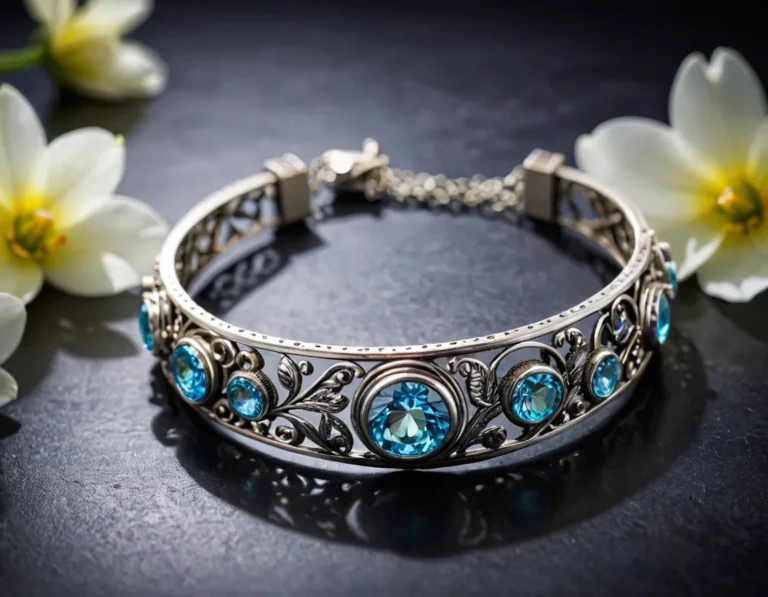7 Different Types of Silver Used in Jewelry
When it comes to silver jewelry, understanding the types of silver used is essential. Different forms of silver have unique qualities, benefits, and uses. This article will help you get to know the most common types of silver found in jewelry, including sterling silver, fine silver, and more.
1. Sterling Silver
Sterling silver is the most popular type of silver used in jewelry. It’s an alloy composed of 92.5% silver and 7.5% other metals, usually copper.
Key Features of Sterling Silver:
- Composition: 92.5% silver, 7.5% copper
- Durability: Highly durable and harder than pure silver
- Appearance: Bright and shiny but may tarnish over time
- Hallmark: Stamped with “925”
Pros and Cons
| Pros | Cons |
|---|---|
| Durable and long-lasting | Can tarnish over time |
| Hypoallergenic (if mixed with copper) | Needs regular maintenance |
| Widely available | May cause allergies if mixed with nickel |
Best For:
- Everyday jewelry
- Rings, bracelets, necklaces
2. Fine Silver
Fine silver is 99.9% pure silver. It is softer than sterling silver and less durable, making it less common in everyday jewelry.
Key Features of Fine Silver:
- Composition: 99.9% silver
- Durability: Softer and more prone to scratching
- Appearance: Bright, shiny, and more resistant to tarnish
- Hallmark: Stamped with “999”
Pros and Cons
| Pros | Cons |
|---|---|
| Highly resistant to tarnish | Softer and more prone to damage |
| Hypoallergenic | Not ideal for everyday wear |
| Purest form of silver | Expensive |
Best For:
- High-end jewelry
- Earrings, pendants, and items not subjected to rough wear
3. Argentium Silver
Argentium silver is a modern silver alloy that contains a higher percentage of silver than sterling silver. It typically includes germanium, which enhances its properties.
Key Features of Argentium Silver:
- Composition: 93.5% or 96% silver, mixed with germanium
- Durability: More durable than sterling silver
- Appearance: Tarnish-resistant and brighter than traditional sterling
- Hallmark: Stamped with “930” or “960”
Pros and Cons
| Pros | Cons |
|---|---|
| Highly tarnish-resistant | More expensive than sterling |
| Requires less maintenance | Less widely available |
| Durable and hypoallergenic | Limited hallmark recognition |
Best For:
- Premium jewelry
- Items requiring low maintenance
4. Coin Silver
Coin silver is an alloy that was traditionally made from melted down coins. It has a slightly lower silver content than sterling silver.
Key Features of Coin Silver:
- Composition: 90% silver, 10% other metals
- Durability: Similar to sterling but slightly less
- Appearance: Can tarnish over time
- Hallmark: Stamped with “900”
Pros and Cons
| Pros | Cons |
|---|---|
| Slightly more affordable | Tarnishes over time |
| Durable | Less silver content than sterling |
| Historical significance | Less common in modern jewelry |
Best For:
- Antique jewelry
- Collectibles
5. Nickel Silver
Nickel silver, also known as German silver, does not actually contain silver. It is an alloy of nickel, copper, and zinc, resembling silver in appearance.
Key Features of Nickel Silver:
- Composition: No silver; made of nickel, copper, and zinc
- Durability: Very durable
- Appearance: Shiny, resembles silver
- Hallmark: No silver hallmark
Pros and Cons
| Pros | Cons |
|---|---|
| Very affordable | No actual silver content |
| Durable and hard | Can cause allergic reactions |
| Shiny and silver-like appearance | Tarnishes and requires maintenance |
Best For:
- Costume jewelry
- Affordable fashion accessories
6. Silver Plated
Silver plated jewelry consists of a thin layer of silver over a base metal. This type is much more affordable than solid silver jewelry.
Key Features of Silver Plated Jewelry:
- Composition: Thin layer of silver over base metal
- Durability: Depends on the thickness of the silver layer
- Appearance: Looks like silver but wears off over time
- Hallmark: Usually no hallmark
Pros and Cons
| Pros | Cons |
|---|---|
| Very affordable | Silver layer can wear off |
| Looks like solid silver | Base metal can cause allergies |
| Good for temporary use | Requires careful maintenance |
Best For:
- Fashion jewelry
- Trendy pieces
7. Thai Silver
Thai silver, also known as Hill Tribe silver, is hand-crafted and typically has a higher silver content than sterling silver.
Key Features of Thai Silver:
- Composition: Often 95-99% silver
- Durability: Softer but durable due to thicker pieces
- Appearance: Unique, often matte finish
- Hallmark: Hand-marked, no standard hallmark
Pros and Cons
| Pros | Cons |
|---|---|
| High silver content | Can be softer than sterling |
| Unique, artisanal designs | May not have standardized hallmark |
| Often handmade | Less consistent in quality |
Best For:
- Unique, artisanal jewelry
- Collectors’ items
Conclusion
Understanding the different types of silver used in jewelry can help you make informed choices. Whether you prioritize purity, durability, or affordability, there’s a type of silver to suit your needs. Here’s a quick comparison table to wrap things up:
Quick Comparison Table
| Type of Silver | Silver Content | Durability | Tarnish Resistance | Best For |
|---|---|---|---|---|
| Sterling Silver | 92.5% | High | Moderate | Everyday wear |
| Fine Silver | 99.9% | Low | High | High-end, occasional wear |
| Argentium Silver | 93.5-96% | Very High | Very High | Premium, low maintenance |
| Coin Silver | 90% | Moderate | Moderate | Antiques, collectibles |
| Nickel Silver | 0% | Very High | Low | Costume jewelry |
| Silver Plated | Thin layer | Low | Low | Fashion jewelry |
| Thai Silver | 95-99% | Moderate | Moderate | Artisanal pieces |
By choosing the right type of silver, you can enjoy your jewelry to the fullest. Happy shopping!
